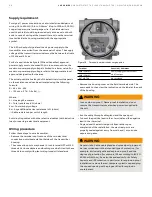
16
LMT S E R I E S |
M AG N E TOS T R I C T I V E L E V EL T R A N SM I T T ER | O I/L M T 10 0/ 2 0 0 - EN R E V. B
• Remove the insulation blanket from the MLG just enough to
slide the gear clamps between the scale assembly and the
level gauge chamber It may be necessary to loosen the gear
clamps holding the scale to the MLG to install the transmitter
clamps
• Mount the LMT Series transmitter to the MLG using the gear
clamps by allowing the LMT Series transmitter mounting
clamps to pierce the holes in the insulation blanket
• Align the factory zero mark with a “0” measurement mark on
the scale or the center of the bottom process connection and
tighten all gear clamps
• Re-attach the insulation blanket
• Proceed with electrical installation (Refer to Section 6
“Transmitter Wiring”)
Cryogenic (low temperature) applications
• As an option, some cryogenic transmitters are mounted in
insulation wells attached to the level gauge This allows the
removal of the transmitter from service without removing the
insulation
• Insulation wells mount to the MLG using the included gear
clamps and following the steps in the mounting of standard
units
• Insulate the MLG and insulation well, per end user
specifications
90° Probes
Select LMT Series of transmitters are manufactured with a 90°
bend near the housing to distance the electronics housing from
the temperature of the process, to remote the sensor from the
chamber or to allow access to the electronics when the sensor
mounted under cryogenic insulation These are identified by
the model number as XXX-SEH These select transmitters are
equipped with a mounting bracket that must be attached to
the body of the level gauge with a transmitter clamp
Top Mount
Bottom Mount
Figure 12 90° Top / Bottom Mount
Transmitter removal
• Remove electrical power from the transmitter
• Disconnect the transmitter field wiring and electrical
connection
• Loosen the gear clamps and remove the transmitter from the
MLG
• Be careful not to bend the sensor tube Transmitters over
8-feet in length should be handled with care and assistance
• The LMT Series transmitter installed in an insulation well may
be removed by loosening the compression fitting and sliding
the sensor out of the tube
IMPORTANT NOTE
When installing/removing a sensor into/from a sensor well, a
wrench shall be used on both the sensor, and the sensor well
The sensor installation torque shall not be transferred to the
sensor well Refer to Figure 7
LMT200 valve positioner
In the valve positioning application, the transmitter is bolted to the
yoke of the actuator with two mounting brackets that are supplied
with the transmitter A third bracket is secured to the stem
connector This bracket holds the magnet that provides the signal
to the transmitter The clearance between the magnet and the
sensing tube of the LMT200 is approximately 6 35 mm (1/4 in) This
dimension is not critical and can vary slightly along the length of
the transmitter The magnet should not contact the sensing tube
at any point in its travel The brackets supplied with the transmitter
do not include mounting holes These will be drilled in the field to
accommodate the various sizes of actuators that will be
encountered The transmitter is calibrated in place by using either
the integral HMI display or handheld devices The vertical
alignment of the transmitter is not critical and the zero and span
can be set anywhere along the active portion of the transmitter
Figure 13 LMT200 Valve Positioner
















































